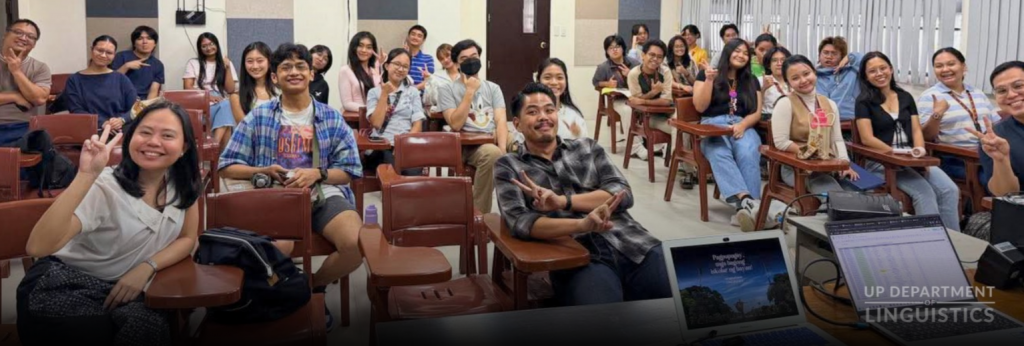
The BA Linguistics program offers a comprehensive study of languages—not just by studying one or two foreign tongues, but by embracing the richness of Philippine languages. It explores the various languages spoken across the archipelago and examines their linguistic roots within the Austronesian language family.
What is Austronesian and Philippine Linguistics? And Why Is it Special?
Austronesian linguistics is a branch of linguistics that focuses on Austronesian languages. The Austronesian language family is one of the largest language families in the world, which includes languages like Tagalog, Cebuano, Ilocano, and all other native Philippine languages, as well as Malay and Indonesian, Javanese, Malagasy (spoken in Madagascar), Hawaiian, Maori (spoken in New Zealand), and many, many more. If you’ve watched Moana, the songs “we know the way” and “logo te pate” are mainly in Samoan and Tokelauan, two Austronesian languages of the Oceanic branch.
The most heavily supported theory about the origin of Austronesian languages is called the Out-of-Taiwan Theory— our Austronesian ancestors lived on Taiwan before migrating South to Northern Luzon. This theory is well supported by linguistic evidence: the Taiwanese aboriginals speak Austronesian languages too, but their languages are more different from each other than any Austronesian languages found outside Taiwan. This suggests that Austronesian languages have been in Taiwan much longer, giving them more time to evolve and become distinct. Meanwhile, the languages outside Taiwan are more closely related, meaning they likely spread more recently from a common source, which is Taiwan.

For example, Amis and Bunun, two Formosan languages (Austronesian languages of Taiwan) that border each other, are more different from each other than Tagalog and Malagasy, spoken on Madagascar in Africa, despite being situated on two different continents! Since the Formosan languages are so different, it is logical to think that they have had more time to diversify, while the Malayo-Polynesian languages have had less time to evolve, meaning that the latter’s “proto-language” (a theorised ancestral language) must have left Taiwan and diversified after Bunun and Amis had already split from proto-Austronesian!
Philippine languages, sometimes believed to have descended from proto-Philippine (though not all agree if it truly existed), are fascinating due to a relatively conservative grammatical feature. In linguistics, something being “conservative” doesn’t mean they are against LGBTQA rights or anything of the sort, but simply because they contain elements of grammar, phonetics, or lexicon that are “remnants” of an older language (in this case, Proto-Malayo-Polynesian and Proto-Austronesian) that neighbouring languages have lost or abandoned. Philippine languages, along with many, if not most, Formosan languages and the Bornean languages, maintain the Austronesian alignment (aka Symmetrical voice or Philippine-type voice system).

University of the Philippines Department of Linguistics members at the 2025 Department Planning Workshop.
Retrieved at https://www.facebook.com/share/p/1CHdhXPjPo/
Think of the root word ‘kain’, use it as a verb and affix it. Notice that the topicalised noun (the one marked by ang or si[na]) depends on the affix: kumain ang bata ng mangga, kinain ng bata ang mangga, kinainan ng bata ng mangga ang plato, ipinangkain ng bata ng mangga ang kutsara, etc. This is very different to any Indo-European language, and there are only a handful of languages outside the Austronesian family that work similarly and a big reason why Philippine languages are interesting to linguists.
RGH Law
The first analysis of Austronesian languages using the comparative method of linguistics is attributed to the Dutch-Indonesian scholar H.N. van der Tuuk. This significant achievement led to the establishment of what is now known as the RGH law, also referred to as the first van der Tuuk’s first law. This illustrates the recurring sound correspondence of Malay /r/ to Tagalog /g/ and Ngaju Dayak /h/. For example, the Malay word for “vein” is “urat,” which corresponds to the Tagalog word “ugat” and the Ngaju Dayak word “uhat.”
The RGH law is one central feature of Austronesian linguistics. In our beloved proto-languages, both proto-Austronesian (PAn) and proto-Malayo-Polynesian (PMP), it is believed that there was a sound similar to the “French R”, or “voiced uvular fricative” represented by / ʁ/ in IPA and *R when writing PAn and PMP (and PPH). This phoneme, however, has been lost in most, if not all, Malayo-Polynesian languages, and has evolved quite early on in most languages.
This sound change law can help us in classifying branches of Philippine and other Malayo-Polynesian languages. So, all Greater Central Philippine languages, such as Tagalog, Cebuano, Bikol, Mandaya, Maguindanao, and others, have *R>g. All Central Luzon languages, such as Kapampangan, Hatang Kayi (Remontado Dumagat), and Binubulinao, among others, have *R>y. Bilic languages, such as Tboli, Blaan, Tiruray, and maybe Klata, as well as the Kalamian languages, such as Calamian Tagbanwa and Agutaynen, have *R>l. Ilokano generally has *R>r, but sometimes *R>g.
This law is crucial to know about, but it is also important to understand that, like with all linguistic “laws”, there are exceptions, either due to phonetic context or loanwords. So, while in Tagalog we have bayani, the proto-word would be *baRani. In Cebuano, we have bagani, and in Malay, we have berani. In Tagalog, however, it is bayani, likely because it is a loanword from Kapampangan, or at least from a Central Luzon language!
Here are some readings for you to get ahead (you’ll probably read them in class), but make sure to read them with a grain of salt, as some linguistic theories and subgroupings change over time:
- BLUST, R. (1984). The Austronesian Homeland: A Linguistic Perspective. Asian Perspectives, 26(1), 45–67.
- BLUST, R. (2005). The Linguistic Macrohistory of the Philippines: Some Speculations
- CONANT, C. E. (1911). The RGH Law in Philippine Languages
- CONSTANTINO, E. (1971). Tagalog and Other Major Languages of the Philippines.
- HIMMELMANN, N. P. (1991). The Philippine Challenge to Universal Grammar.
- REID, L. A. (1982). The Demise of Proto-Philippine.
- NOLASCO, R. (2004). Kung Bakit ang mga Kategoryang Subject at Object ay Hindi Angkop sa mga Wikang Pilipino
- ZORC, D. R. (1977). The Bisayan Dialects of the Philippines: Subgrouping and Reconstruction
